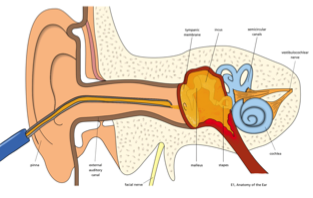Grommet Insertion
What is a grommet?
A grommet is a tube that sits across the ear drum allowing the middle ear to be ventilated
Grommets are usually inserted to treat glue ear
How are grommets inserted?
The operation is performed as a day surgery under general anaesthesia, and the whole procedure including the anaesthesia usually takes 20 to 30 minutes. The procedure is often combined with an adenoidectomy.
The operation involves 3 Stages:
Stage 1
Making an incision in the tympanic membrane - myringotomy
Stage 2
Removal of the glue by micro-suction:
Stage 3
Insertion of the grommet into the tympanic membrane:
What to expect after the operation?
The surgery is relatively painless and most children are back to their normal selves within a couple of hours after waking from anaesthesia. They are not aware of the presence of the grommet. If there is some discomfort this will respond well to simple pain control such as Calpol.
There may be some discharge from the ears which usually settles within a few days. Antibiotic drops are often prescribed to use for a few days to stop any discharge drying and blocking the grommet.
A clinic check is needed 2 weeks after surgery to ensure that the grommet is functioning and that the hearing has recovered.
What can go wrong after grommet insertion?
Ear infections / discharge
This is the most common complication from grommet insertion. About 25% of children will have one ear infection while the grommet is in place. These present as a discharge and are not usually painful.
Infections are often due to water contamination - swimming may have to be restricted if this is a recurrent problem.
They may also occur with a cold that results in a middle ear infection which discharges through the grommet.
Treatment consists of topical antibiotic drops and avoiding water contamination. For older children it is recommended that ear protection is worn when swimming and customised ear plugs are an option. At bath time particularly when washing hair the ear must be protected to prevent soapy water from going through the grommet and cotton wool smeared with vaseline placed in the ear canal is usually sufficient or if you have custom made plugs these can be used at bath time and for swimming
It is important to have the ear checked after the infection has resolved to ensure that the grommet has not been pushed out or become blocked.
Scarring
Tympanosclerosis, scarring of the eardrum, may occur but is usually of no consequence. Such scarring may also occur with glue ear and ear infections.
Residual perforation
In most cases, as the grommet comes out, the hole behind closes. Although, in 1-2% of children this may not happen. If the perforation fails to close, then further surgery is needed to close the perforation - and this is carried out after the age of 8..





